In the beginning, there was the Solstice.
When iRacing launched its open beta in 2008, more than a year before I joined the service, it had just two cars: the Skip Barber Formula 2000 and the Pontiac Solstice.
Ten years later, there are more than six dozen laser-scanned cars available within iRacing, but those two originals remain. Last summer, I took the Skip Barber for a spin — both figuratively and literally — and found it to be surprisingly fresh for such an old car. Participation was good, the car drove nicely, and it doesn’t look graphically outdated like you’d expect from a 10-year-old car. Of course, that’s at least partially because it has received several physics and visual buffs over the years.
The Solstice hasn’t received quite as much TLC, and in some ways, it shows. The car’s interior isn’t exactly photorealistic, and other than fitting it with new tire models, its physics have changed very little. It’s fairly safe to say that rookies on iRacing in 2018 are driving largely the same Solstice as rookies in 2008.
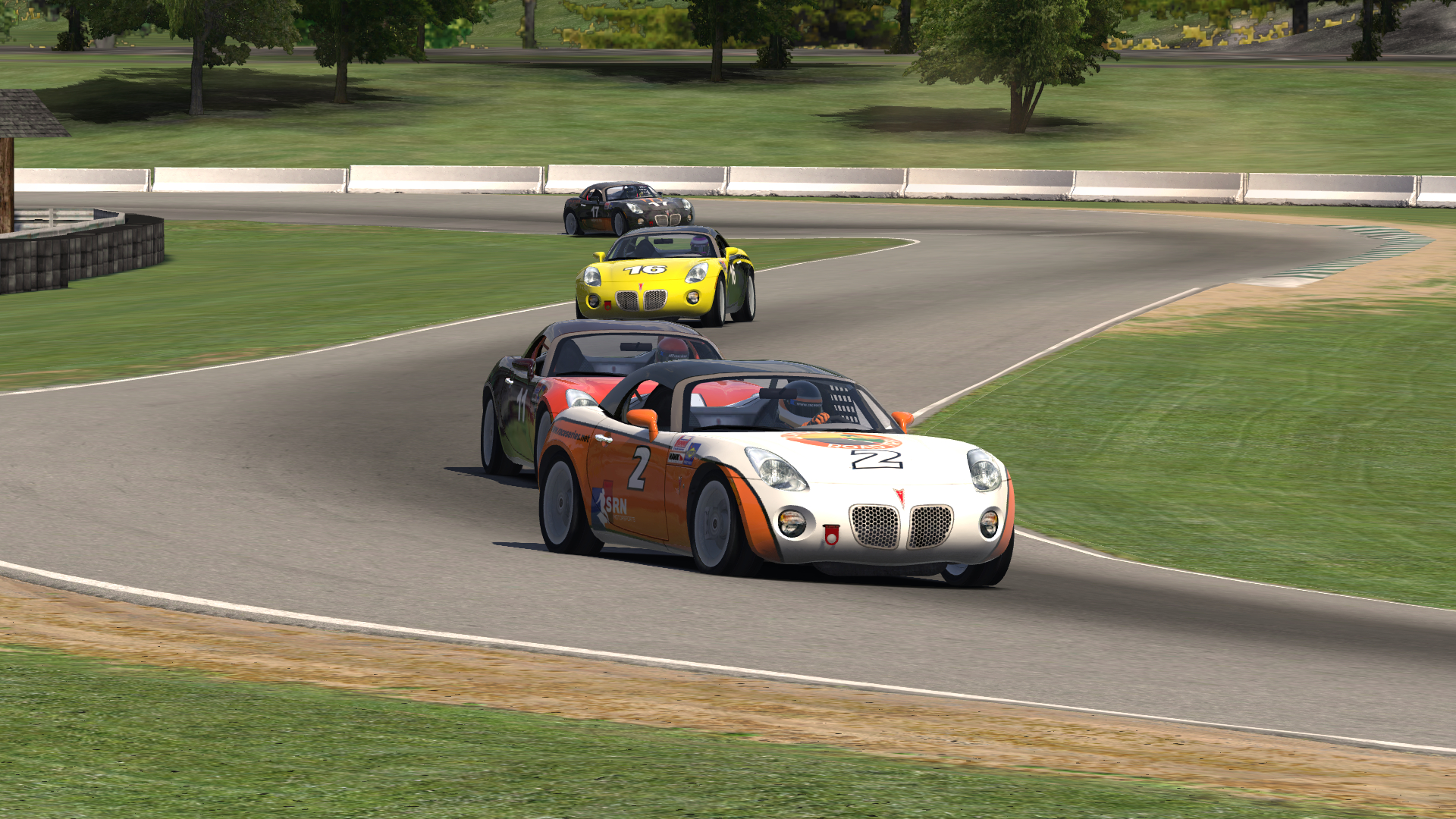
Solstices at Lime Rock Park — now a decade-old combination on iRacing.
That doesn’t mean it’s a bad car, though. Perhaps it’s just the nostalgia talking, but the Solstice holds a special place in my heart because it’s the car I learned to road race with. It’s what I drove to my first iRacing win. And for many years, the Solstice was the rookie car; you couldn’t advance your license class without driving it.
Once the Mazda MX-5 Cup and Roadster cars came to iRacing in the fall of 2010, the Solstice was demoted — or promoted? — to the advanced rookie series, once known as the inRacingNews Challenge and now called the Production Car Challenge.
At first, it was paired with the Spec Racer Ford — a not-entirely unrealistic combination given that iRacing’s version of the Solstice was also sanctioned by the Sports Car Club of America. Later, the MX-5 Roadster joined the series, and when the 2016-spec Global MX-5 Cup car was released, it replaced its Mazda older brother.
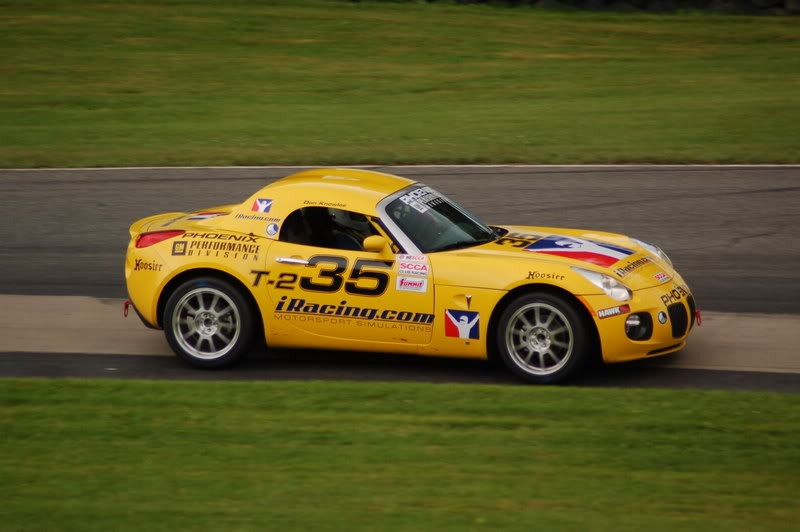
The original SCCA Solstice scanned by iRacing. Photo courtesy of Don Knowles.
The common denominator has been the Solstice — a rookie series mainstay in iRacing for ten years and counting. However, when surveying the road racing landscape before this Summer Road Trip, I saw a distressing statistic. Solstice participation in the Production Car Challenge series was on the decline. Some races included just two or three Solstices amid more than a dozen Mazdas.
I found a similar multi-class mismatch last week in the Global Challenge series, and I worried that the Solstice could be going the way of the Kia Optima — effectively drowned out of a series where it rightfully belongs.
While my week-two racing time was limited by a vacation — an actual summer road trip — I did find some time to dip my toes into the water of the current Production Car Challenge series to assess whether the Solstice still has a purpose, and if the road out of rookies should still go through that car.
Pre-Race Prep
Since graduating from iRacing’s rookie ranks back in 2009, my time in the Solstice has been limited. I drove it in time trial competition a few years ago, but to be ready to race, I needed to knock the rust off and get back up to speed.
Although the available setup options are limited, one essential is decreasing the fuel load. For a 20-lap race, the baseline setup had more than four times as much fuel as I would need, and unlike the gentlemanly Lotus 49 drivers I encountered last year, I wasn’t about to handicap myself by driving with any extra weight.
After running a few test laps and briefly studying a faster driver’s reference lap on Virtual Racing School, I signed up for a race and was a bit surprised to see a half-dozen other Solstice drivers also registered. We were still vastly outnumbered — across three splits, there were 45 MX-5s compared to just 7 Solstices — but we at least occupied a decent chunk of the top split.
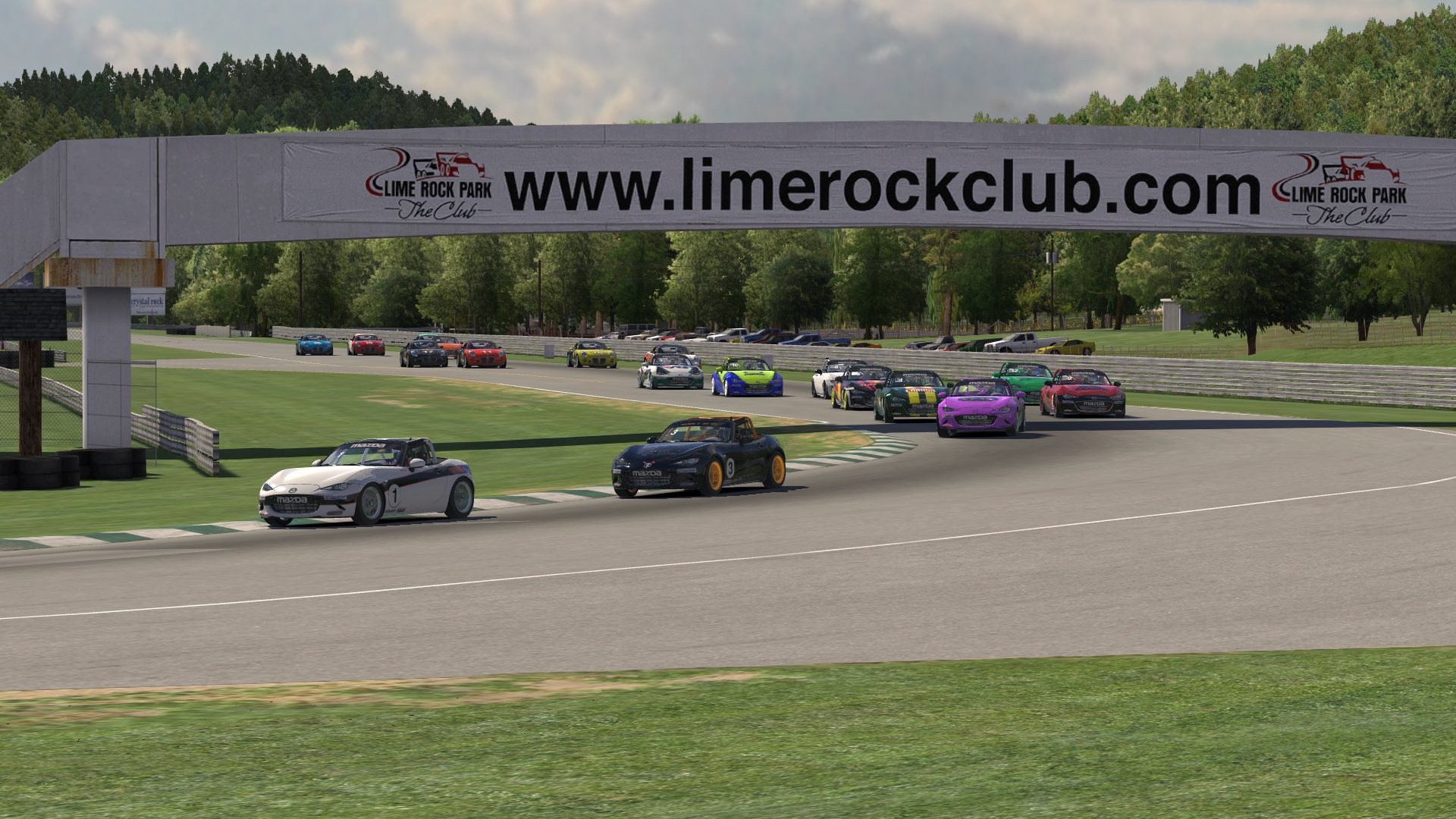
Mazdas lead the field into turn 1 at the start of the race.
In qualifying, all of the Mazda drivers were more than two seconds quicker than me in the pole-sitting Solstice. The last time I raced this series, there was some pace overlap between the Solstices and MX-5 Roadsters. However, the new Mazdas have much better acceleration and a slight top speed advantage, which adds needed separation between the classes.
At the start of the race, the Mazda pack easily distanced themselves from the Solstices, a few spinning stragglers notwithstanding. Once those Mazdas got past me and I pulled out several seconds over the second-place Solstice, I wanted to put my Pontiac through its paces.
Over the Limit
While it’s certainly not the fastest car — hence it’s “Slowstice” nickname — or even the most fun to drive, the Solstice is good for learning about weight transfer, finding the right driving line, and gaining overall consistency behind the wheel.
After running a race lap within 0.002 seconds of my best qualifying lap, I decided to push to find a bit of extra speed. I thought that I could gain some time by braking slightly later into turn 1, so I drove in deep… and sailed completely off the other side of the track.
After a bit of offroading, I got back on track but my lead had evaporated. Fortunately, the forgiving nature of the Solstice hadn’t yielded a harsher punishment. In many cars, touching the icy grass at Lime Rock leads to an inevitable slide into the wall. This time, I was able to recover.
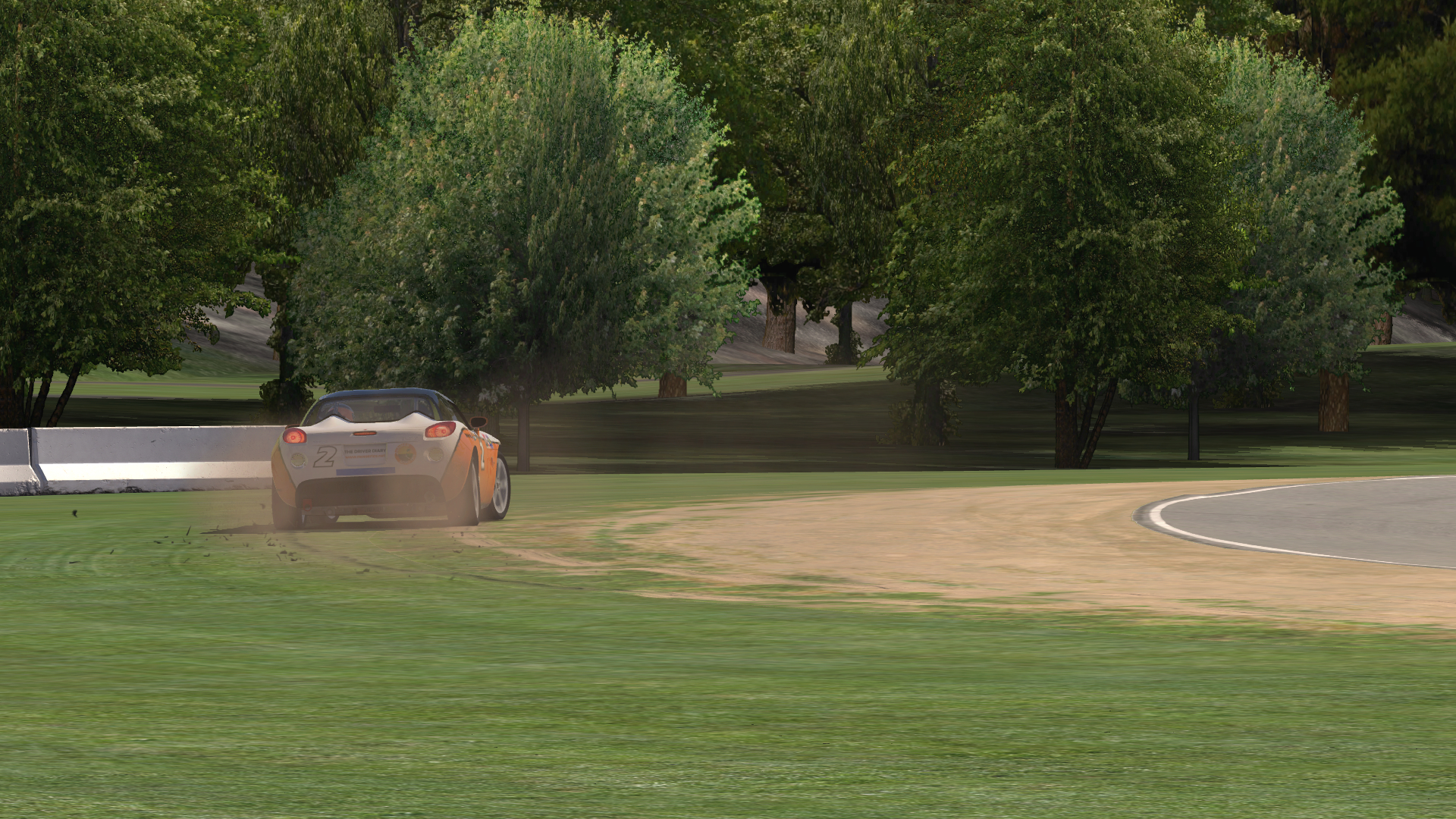
Testing the Solstice’s offroad abilities — and iRacing’s new dirt and grass effects.
Although having the second-place car on my bumper could have been a distraction, I was able to focus on getting into a rhythm — another reason the Solstice is a solid training tool — and once again extend my lead.
By the middle of the race, I began to encounter traffic, including some slower Solstices ahead of me and the leading pair of Mazdas approaching from behind. With many years of multi-class racing experience in much faster cars under my belt, it was easy enough to manage this traffic, but it wasn’t always so stress-free for me, and I suspect the same is true for lots of rookies. That’s one nice aspect of this series in its current form: the races are short enough that traffic is limited, but it’s not non-existent.
That traffic aside, the final laps were uneventful and I came to the checkered flag with a win, but more importantly, with a better appreciation and a new perspective of the Solstice, the Production Car Challenge series, and their roles within iRacing.
Production Car Challenge
Sunday, June 24 at 6:30 pm EDT • Strength of Field: 1456| Finish | Start | Interval | Laps Led | Fastest Lap | Incidents | Points | iRating | Safety Rating |
|---|---|---|---|---|---|---|---|---|
| 1 | 1 | Winner | 19 | 1:00.884 | 2 | 80 | 5113 (+13) | A 4.85 (-0.10) |
Series Status
To be completely honest, entering my race this week, I thought this series had become redundant. After all, both of its cars are featured in other series — the Mazda is also in a standalone rookie-level series and the Advanced Mazda MX-5 Cup C-class series, and the Solstice is the slowest of three classes in the D-class Grand Touring Cup, where its participation is better.
But the Production Car Challenge series does fill the important role of preparing rookies to join iRacing’s variety of higher-class GT series by easing them into multi-class interaction while racing on more circuits — all free content — than the rookie MX-5 series.
I would absolutely encourage Mazda drivers to race in the Production Car Challenge. As with its single-class rookie counterpart, it provides well-populated hourly races and, judging by the race I joined, some close competition to boot.
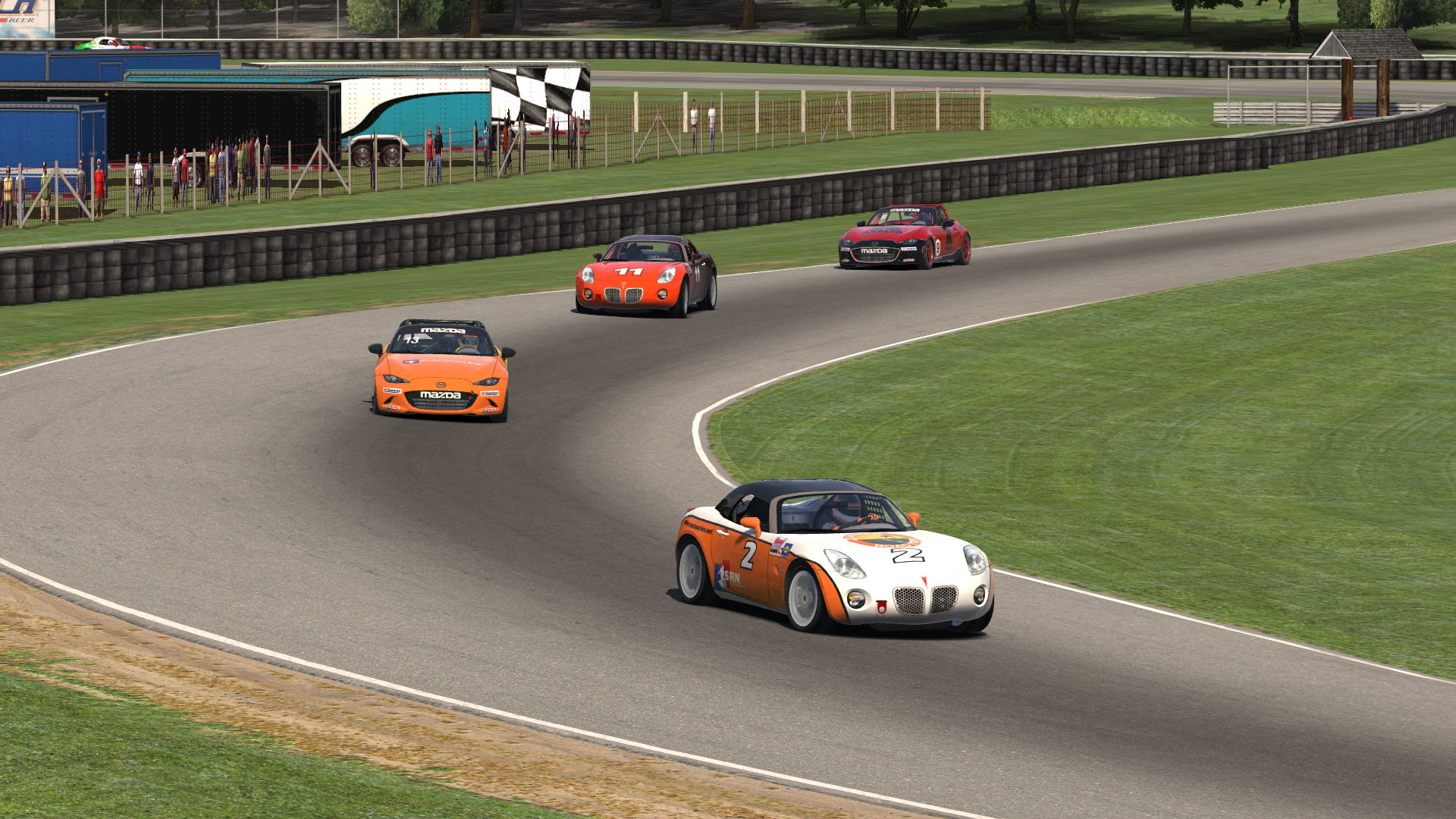
Solstices and Mazdas intermingle in the Production Car Challenge series.
While two of the Solstices in my race had a side-by-side run to the finish, that’s not likely to be the case for everyone. However, that’s not necessarily a bad thing. For Solstice drivers, this series is a good learning environment to adjust to the car’s tendencies and finicky transmission before advancing to the Grand Touring Cup, which sometimes sees packs of Solstices battling with each other.
With a solid development system in place for Solstice drivers, I’m pleased to say that this car is not an endangered species like the Kia. Instead, like the horseshoe crab or the jellyfish, the Pontiac Solstice — one of the oldest specimens in the iRacing catalog — seems to have found its niche in the ecosystem to help it withstand the test of time.